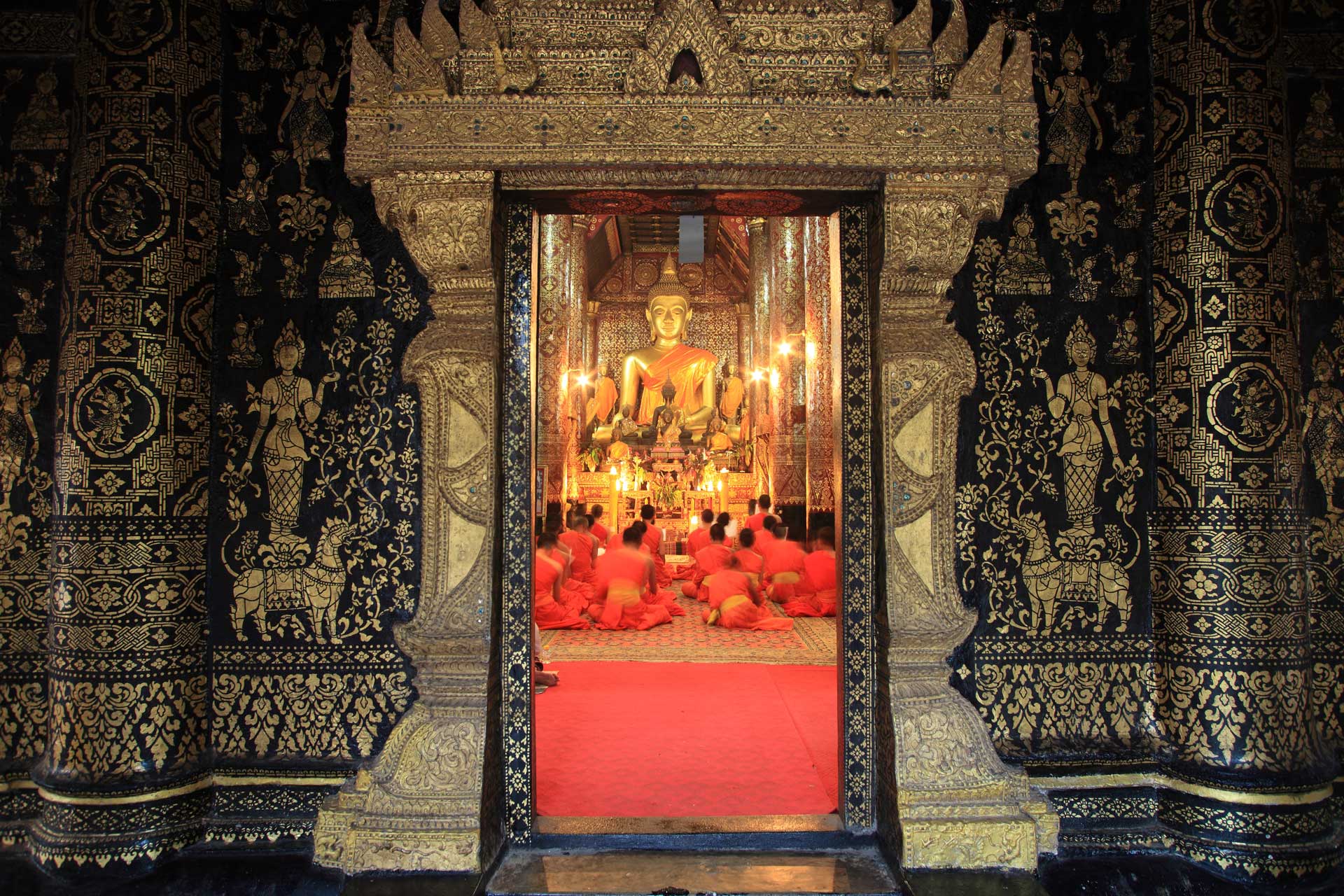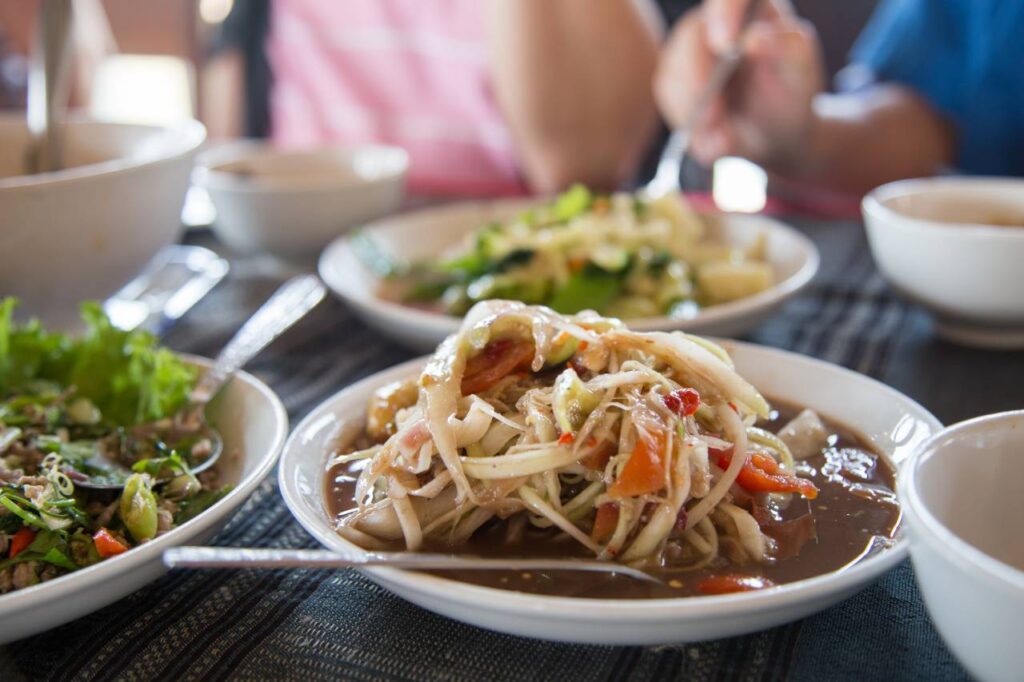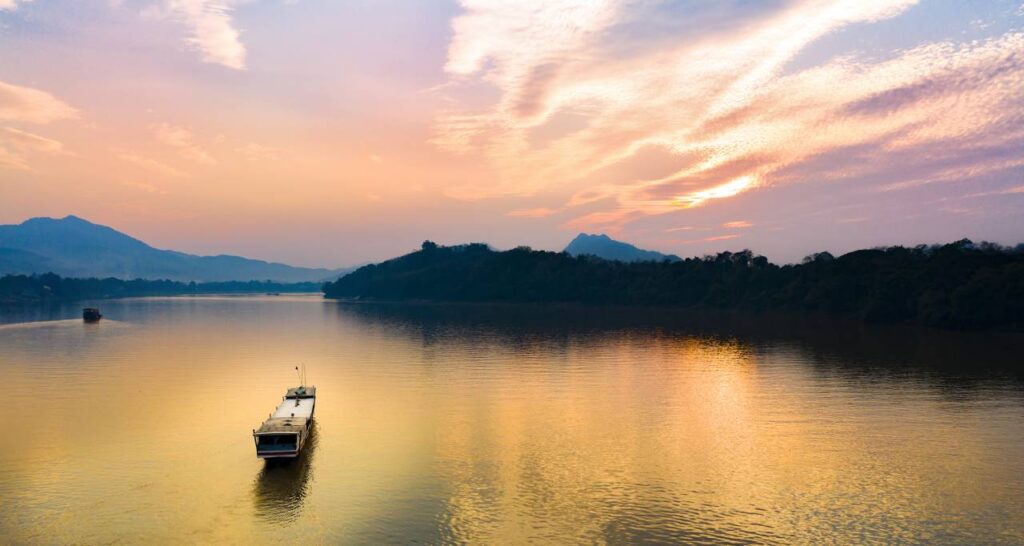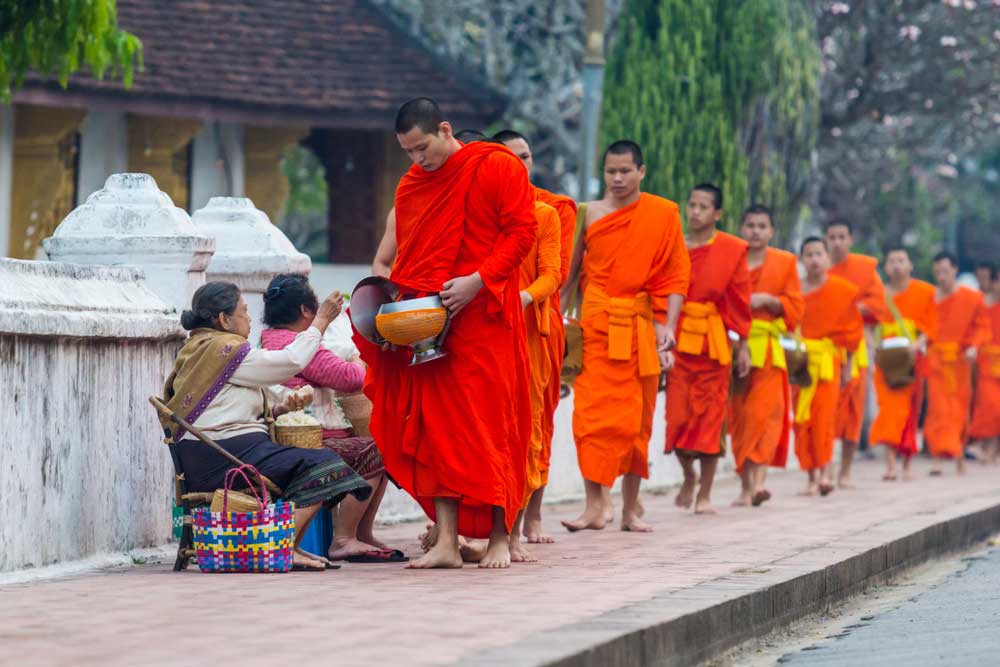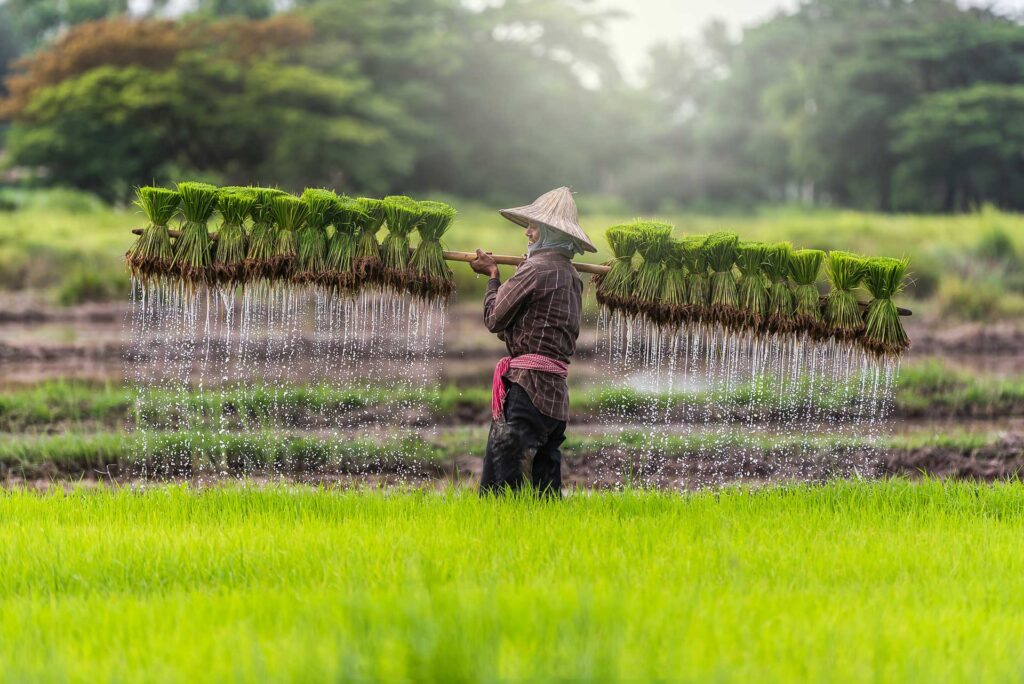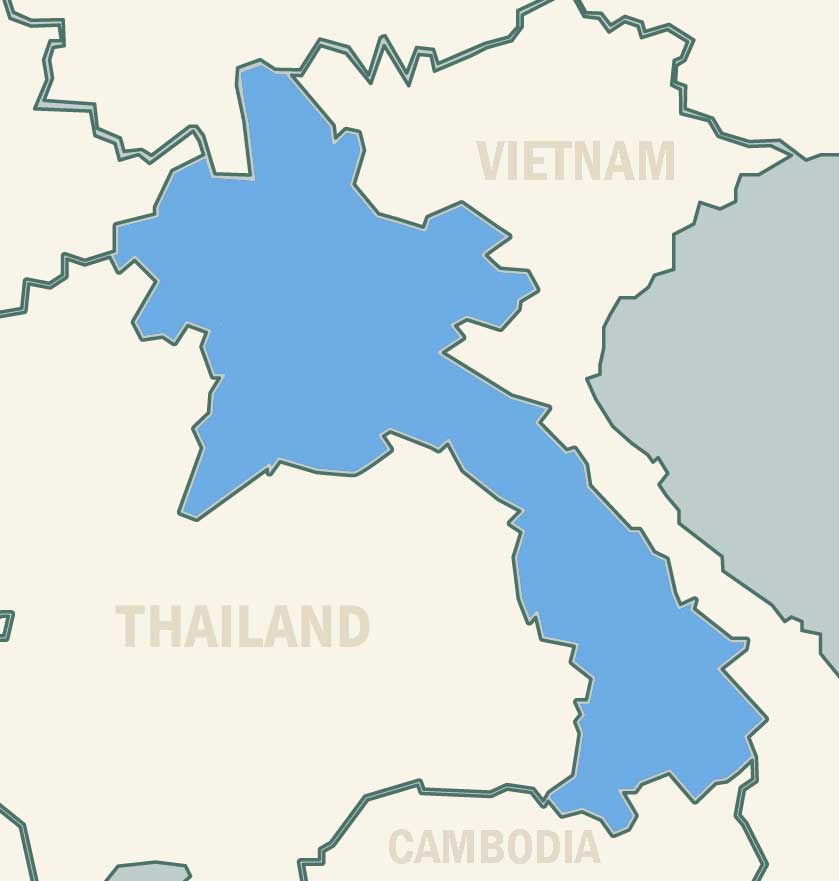If you’re looking for an authentic destination to visit then experience Laos in all its majestic beauty. Natural in almost every aspect, Laos is one of Southeast Asia’s least developed nations offering the adventurous tourist a land of many surprises. It is still a relatively undiscovered country that has escaped the dramatic industrial development of its neighboring countries.
laos_flag
Laos, also known as the Land of a Million Elephants, is a culturally rich, land-locked country with a population of just over 6 million. The Laotians are predominantly Buddhist and are very friendly and hospitable people. The official language is Lao, but English is widely spoken. The capital city, Vientiane, skirts the Mekong River, which forms the border between Laos and Thailand.
In Vientiane, you should pay a visit to the temples of Wat Phra Keo, Wat Si Saket and the splendid sight on top of the ‘Arc de Triomphe’ offering a superb view on of the surrounding natural area of Vientiane. One of nation’s most important temples is the That Luang Stupa, which should not be missed. During the afternoon, if you have time, stop by the National Cultural Ethnic Park, the Friendship Bridge or the bizarre Buddha Park. In the morning, don’t miss the market where you can buy anything from local handicrafts to MP3 players and traditional medicine.
The second destination of Laos is Luang Prabang, a UNESCO World Heritage Site that deserves to be seen. There, among other things, you can enjoy a walk to the top of the Wat Phousy overlooking the Mekong River, for splendid views of adjacent land. Later, you can discover the stunning and beautiful Wat Xieng Thong Temple. In former times the oldest temple of Luang Prabang played a major role during cremation ceremonies for the Laotian kings.
His successors helped establish Buddhism as the predominant religion of the country.
TIMELINE
18th Century
Conflicts with Thailand, Vietnam and Cambodia
1907
Franco-Siamese treaty that defined the border between Laos and Thailand
1945
Formation of Independent government under Free Laos Banner
1947
France recognized the independence of Laos
1960
paratroop captain seized Vientiane in a coup
1972
Lao People’s Revolutionary Party (LPRP) joined a new coalition government
1975
The King renounced his throne
In the 18th century Lane Xang entered a period of decline caused by dynastic struggle and conflicts with Burma Siam, now Thailand, Vietnam and the Khmer kingdom. In the 19th century the Siamese established hegemony over much of what is now Laos. The region was divided into principalities centered on Luang Prabang, Vientiane and Champassak. Late in the century the French supplanted the Siamese and integrated all of Laos into the French empire. The Franco-Siamese treaty of 1907 defined the present Lao boundary with Thailand.
During World War II the Japanese occupied French Indochina including Laos. In September 1945 Vientiane and Champassak united with Luang Prabang to form an independent government under the Free Lao banner. In 1946 French troops reoccupied the country and conferred limited autonomy on Laos following elections for a constituent assembly.
France formally recognized the independence of Laos within the French Union in 1949 and Laos remained a member of the Union until 1953. Pro-Western governments held power after the 1954 Geneva peace conference until 1957 when the first coalition government led by Prince Souvanna Phouma was formed. The coalition government collapsed in 1958 amidst increased polarization of the political process. Rightist forces took over the government and a communist insurgency resumed in 1959.
In 1960 a paratroop captain seized Vientiane in a coup and demanded formation of a neutralist government to end the fighting. The neutralist government newly in place was driven from power later that same year by rightist forces. In response, the neutralists allied themselves with the communist insurgents and began to receive support from the Soviet Union. The rightist regime received support from the U.S.
A second Geneva conference was held in 1961-1962 and provided for the independence and neutrality of Laos. Soon after accord was reached the signatories accused each other of violating the terms of the agreement and with superpower support on both sides the civil war soon resumed.
In 1972 the Lao People’s Revolutionary Party (LPRP) joined a new coalition government after the Vientiane agreement of February 21, 1973 went into effect that same year. Nonetheless the political struggle between communist’s neutralists and rightists continued. The collapse of Saigon and Phnom Penh in 1975 hastened the decline of the coalition. On December 1975 the king renounced his throne in the constitutional monarchy and entrusted his power to the Lao people but the LPRP dissolved the coalition cabinet and the communist Lao People’s Democratic Republic (LPDR) was established.
The new communist government imposed centralized economic decision-making and broad security measures including control of the media and the arrest and incarceration of many members of the previous government and military in “re-education camps”. These draconian policies and deteriorating economic conditions along with government efforts to enforce political control prompted an exodus of lowland Lao and ethnic Hmong from Laos. About 10% of the Lao population sought refugee status after 1975. Many have since been resettled in third countries including nearly 250,000 who have come to the United States. The situation of Lao refugees is now nearing its final chapter and many have resettled in their homeland.
Laos is a landlocked country bordered to the north by China, to the east by Vietnam, so the south by Cambodia, and to the west by Thailand and Myanmar. Apart from the Mekong River plains along the border of Thailand, the country is mountainous, particularly in the north and in places densely forested.
Laos enjoys a tropical climate with two distinct seasons, the rainy season from the beginning of May to the end of September and dry season from October through April. The yearly average temperature is about 28 C (82F), rising to a maximum of 38 C (100F) in April and May.
In Vientiane minimum temperatures of 19 C (66F) can be felt in January. In mountainous areas, temperatures drop to 14-15 C (58F) during the winter months, and during cold nights easily reach the freezing point.
The average precipitation is highest in southern Laos, where the Annamite Mountains receive over 3000 mm (118 inches) annually.
In Vientiane rainfall is about 1500-2000 mm (59 to 79 inches), and in the Northern provinces only 1000-1500 (39 to 59 inches) mm.
Buddhism first appeared in Laos during the 18th century A.D. The unified Kingdom of Lane Xang, in the 14th century declared Buddhism as the state religion and urged the people to abandon animism or other beliefs such as the cult of spirits.
The policy was meant to develop the Laotian culture around one common faith, Theravada Buddhism.
Today, this form of Buddhism is now the professed religion for 90% of the Lao people. Buddhism is an inherent feature of daily life and casts a strong influence on the society. Lao woman can be seen each morning giving alms to monks, earning merit to lessen the number of their rebirth. Lao men are expected to become a monk for at least a short time in their lives. Traditionally, they spend three months during the rainy season in a Buddhist temple. But nowadays most men curtail their stay to one or two weeks.
The Laotians are known to be friendly and smiling people who love liberties with no quarrels or oppressions. They hold great respect for the nation and most live with honour and respect for others. A typical example illustrative of this well-known friendliness is the way in which inhabitants welcome strangers with a free meal.
Friendship, love and peace sit in the hearts of Lao people. They hate conflicts or oppressors and their slogan is “united we survive and separated, we die.” They enjoy literature and arts, and the country’s ancient heritage arises from the national poetry that illustrates the Laotian way of life.
HINTS
The Lao Lum (lowlanders) who make up 70% of the population and predominantly live on Mekong River level.
The Lao Theung (uplands) who comprise 20% of the population and on the foothills with an elevation of less than 1,000 meters (3,280 feet).
The Lao Song (hill tribes) who constitute 10% of the population and live in the mountainous areas.
Theravada Buddhism has contributed greatly to the Lao culture. It is reflected throughout the country in its temples, the language, the arts, literature, performing arts and more. Laotian music is dominated by its national instrument, the khaen, a type of bamboo pipe.
Houses are built on stilts and have free space underneath the roofs with a triangle wind plates on each side. There are two types of houses; single and a double roofed. The number of steps depends on the height of the house, but traditionally they’ll have an uneven number.
The dress depends on gender and age. Lao women are dressed properly and seen traditionally as the mothers of the nation. Lao women wear silk skirts, blouses and scarves to attend important ceremonies. During significant events, Lao women wear scarves and coiled hair styles. Lao men wear salong, big large pants, or peasant pants, to attend important ceremonies.
